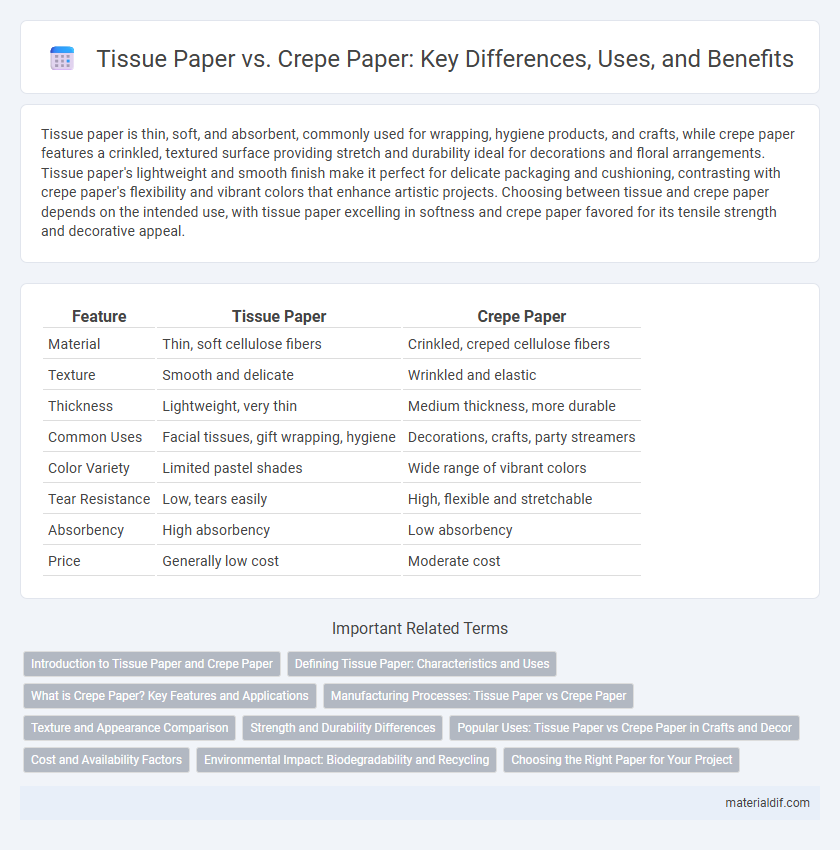Tissue paper is thin, soft, and absorbent, commonly used for wrapping, hygiene products, and crafts, while crepe paper features a crinkled, textured surface providing stretch and durability ideal for decorations and floral arrangements. Tissue paper's lightweight and smooth finish make it perfect for delicate packaging and cushioning, contrasting with crepe paper's flexibility and vibrant colors that enhance artistic projects. Choosing between tissue and crepe paper depends on the intended use, with tissue paper excelling in softness and crepe paper favored for its tensile strength and decorative appeal.
Table of Comparison
| Feature | Tissue Paper | Crepe Paper |
|---|---|---|
| Material | Thin, soft cellulose fibers | Crinkled, creped cellulose fibers |
| Texture | Smooth and delicate | Wrinkled and elastic |
| Thickness | Lightweight, very thin | Medium thickness, more durable |
| Common Uses | Facial tissues, gift wrapping, hygiene | Decorations, crafts, party streamers |
| Color Variety | Limited pastel shades | Wide range of vibrant colors |
| Tear Resistance | Low, tears easily | High, flexible and stretchable |
| Absorbency | High absorbency | Low absorbency |
| Price | Generally low cost | Moderate cost |
Introduction to Tissue Paper and Crepe Paper
Tissue paper is a lightweight, thin material often used for wrapping, cushioning, and hygiene products due to its softness and absorbency. Crepe paper features a crinkled texture created by a special drying process, making it ideal for crafting, decorations, and party streamers. Both materials are derived from cellulose fibers but differ significantly in texture, strength, and typical applications.
Defining Tissue Paper: Characteristics and Uses
Tissue paper is a lightweight, translucent material made from thin, soft fibers commonly used for wrapping delicate items and personal hygiene products. Its smooth texture and high absorbency make it ideal for facial tissues, gift wrapping, and decorative crafts. Unlike crepe paper, tissue paper lacks the characteristic crinkled surface, providing a smooth and pliable finish suited for gentle handling and aesthetic applications.
What is Crepe Paper? Key Features and Applications
Crepe paper is a textured, lightweight paper characterized by its crinkled or wrinkled surface, achieved through a special creping process that imparts flexibility and stretchability. Key features include its high absorbency, vibrant colors, and ease of shaping, making it ideal for crafting, floral arrangements, and party decorations. Common applications involve making paper flowers, streamers, and theatrical props, where its durability and bendability enhance aesthetic appeal and structural integrity.
Manufacturing Processes: Tissue Paper vs Crepe Paper
Tissue paper is produced through a refining process where wood pulp is mechanically or chemically treated, pressed, and dried to create a thin, smooth, and soft sheet. Crepe paper manufacturing involves coating tissue base sheets with adhesive and then drying them over a heated drum, which is subsequently creped (scraped) with a blade to create characteristic wrinkles and stretch. The creping process enhances flexibility and texture, distinguishing crepe paper from the simpler, non-creped tissue paper.
Texture and Appearance Comparison
Tissue paper features a smooth, fine texture with a translucent, uniform appearance ideal for delicate wrapping and crafts, while crepe paper has a crinkled, stretchy texture characterized by ridges and a matte finish that adds depth and dimension to decorations. The elasticity of crepe paper allows it to stretch and mold into shapes, contrasting with the more fragile, flat surface of tissue paper. These distinct textural properties make tissue paper suitable for gentle wrapping and layering, whereas crepe paper excels in creating vibrant, sculptural effects.
Strength and Durability Differences
Tissue paper features a lightweight, soft texture with lower tensile strength, making it ideal for delicate applications but less durable under stress or moisture. Crepe paper is engineered with a crinkled, flexible structure that enhances its tensile strength and resistance to tearing, providing superior durability for crafting and wrapping purposes. The distinct fiber alignment and creping process in crepe paper contribute significantly to its robust performance compared to the more fragile tissue paper.
Popular Uses: Tissue Paper vs Crepe Paper in Crafts and Decor
Tissue paper is widely used for gift wrapping, stuffing, and delicate crafts like paper flowers due to its soft, lightweight texture and vibrant colors. Crepe paper, characterized by its crinkled texture and stretchability, is popular in making textured decorations such as garlands, streamers, and elaborate floral arrangements. Both papers serve distinct roles in crafts and decor, with tissue paper offering smooth finesse and crepe paper providing structural flexibility.
Cost and Availability Factors
Tissue paper is generally more cost-effective and widely available in large quantities due to mass production and its common use in consumer products like facial tissues and napkins. Crepe paper, often used for crafts and decorations, tends to be more expensive because of its unique texture and lower production scale, limiting availability primarily to specialty stores. The cost difference and accessibility make tissue paper preferable for everyday uses, while crepe paper suits niche applications despite higher prices.
Environmental Impact: Biodegradability and Recycling
Tissue paper is generally more biodegradable and easier to recycle due to its thinner, less dyed composition, leading to a lower environmental footprint. Crepe paper, often treated with dyes and coatings for durability and texture, decomposes more slowly and poses challenges in standard recycling processes. Choosing tissue paper over crepe paper significantly reduces landfill waste and supports sustainable waste management practices.
Choosing the Right Paper for Your Project
Tissue paper offers a lightweight, smooth texture ideal for delicate crafts such as gift wrapping and flower making, while crepe paper provides a stretchy, textured surface perfect for creating ruffles and intricate paper flowers. Selecting the right paper depends on project requirements like flexibility, durability, and visual effect, with crepe paper excelling in elasticity and volume, and tissue paper favored for its translucence and softness. For projects demanding vibrant colors and structural detail, crepe paper is preferable, whereas tissue paper suits applications needing subtle shading and gentle layering.
Tissue paper vs Crepe paper Infographic

 materialdif.com
materialdif.com